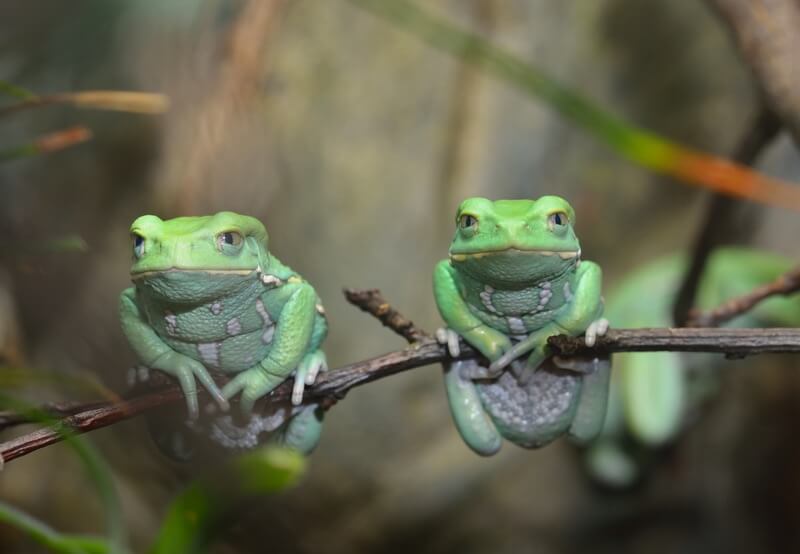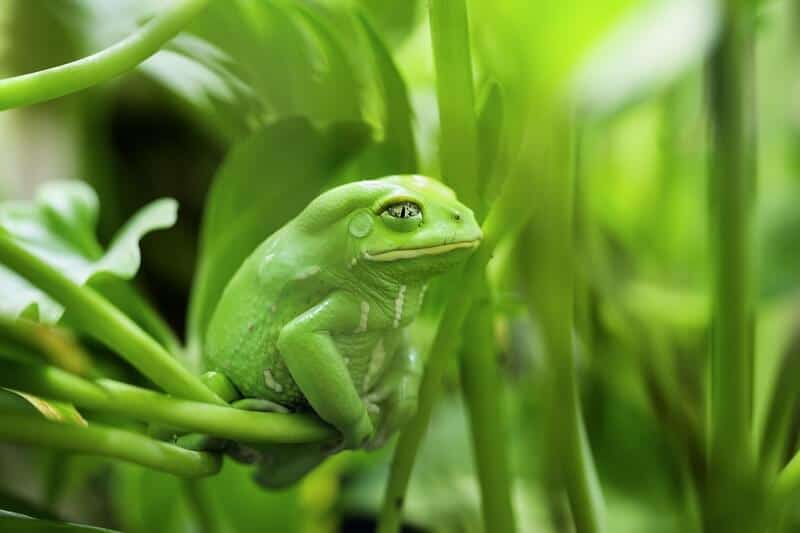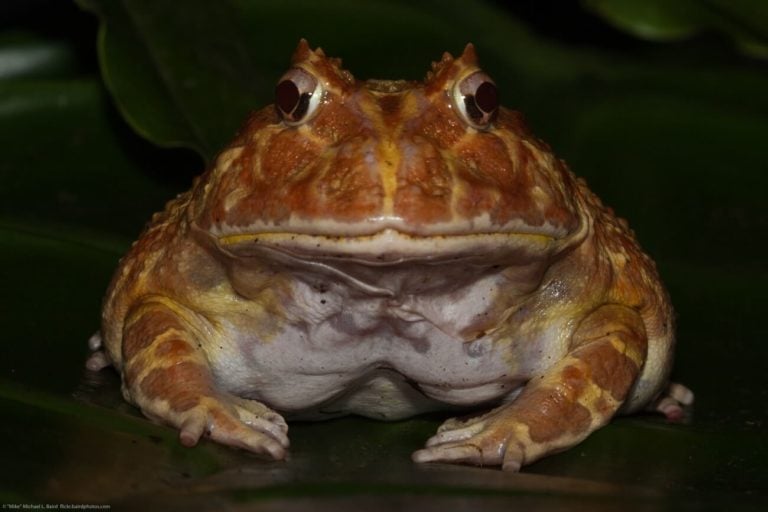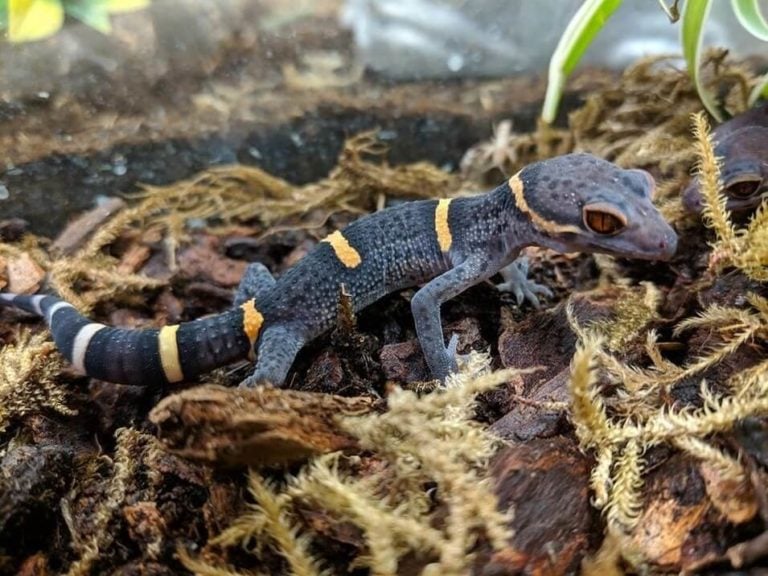Waxy monkey tree frogs are incredibly unique amphibians that are a pleasure to own. With their interesting behavior and appearance, it’s not a surprise that many herp-lovers are interested in owning one!
In the guide below, we’ll go over everything you need to know about waxy monkey tree frog care. This species is one of our favorites!
Table of Contents
Species Summary
The waxy monkey tree frog (Phyllomedusa sauvagii) is an adorable little creature with fascinating biology. While they look similar to other frog species, these guys don’t spend much time hopping around. Instead, they use their prehensile hands to climb around the treetops. That’s how they got the “monkey” part of their common name.
This frog is native to Gran Chaco, a hot and semi-arid lowland forest in South America. The forest spans eastern Bolivia, northern Paraguay, northern Argentina, and parts of Brazil. The waxy monkey tree frog is arboreal and spends almost all of its life in the trees.
These amphibians are well-equipped for their unique lifestyle. However, they’re also adaptable. As a result, they’re pretty popular among herp lovers.
Appearance & Colors
There are two types of waxy monkey tree frogs. The standard variety is bright jungle green. Subtle markings of cream white adorn the belly area and hands. They appear as spots and lines. Some frogs also have larger details that line the mouth.

The second variety is the bicolor waxy monkey tree frog. It also has a bright green color on the top of its body. However, the bottom of the frog is sporting hues of brown and tan.
The secondary color is quite prominent, making the frog look like it’s split in half.
In terms of physical features, these two frogs are nearly identical. Both have agile arms and prehensile hands for climbing. On the head, you’ll find a wide mouth and two bulbous eyes.
Expert Tip: The color of the eyes can vary a bit. For the standard variety, it’s usually cream white. However, the bicolor waxy typically has brown eyes to match the belly.
Lifespan
The typical waxy monkey tree frog lifespan is up to eight years in captivity.
Many factors contribute to an amphibian’s overall life expectancy, so this frog has no guarantees. That said, most experts agree that the level of care you provide does come into play.
Proper waxy monkey tree frog care is important if you want these amphibians to live a long life that’s free of preventable diseases (more on that later).
Average Size
These tree frogs are pretty small. The average waxy monkey tree frog size is around two to three inches in length when fully grown.
The bicolor waxy monkey tree frog gets a bit bigger. Adults can measure three and a half to five inches long.
Expert Tip: For both varieties, females are larger than males. On average, they grow to be about 25 percent bigger!
Waxy Monkey Tree Frog Care
For the most part, waxy monkey tree frog care is fairly simple. This type of pet frog is undemanding and easy-going. They also have several biological processes that make it easier to adapt to a wide range of captive environments.
All that said, there are some basic guidelines to follow. Here’s some need-to-know information to keep any waxy monkey tree frog happy and healthy.
Enclosure Size
A properly sized enclosure is a must when it comes to waxy monkey tree frog care. These critters aren’t huge, so you don’t need a massive tank. However, they do like to climb.
A vertically oriented tank with 20 gallons of volume is a good starting point for single adults. Aim for a habitat that measures at least 18 inches wide by 18 inches long and 24 inches tall. That’s more than enough space for an active adult.
If you want to keep a small group of frogs together, add about 15 gallons of volume for each additional specimen.
Expert Tip: Glass enclosures with adjustable ventilation slots will work just fine. You can also use a screened habitat if you live in a somewhat humid area.
What to Put in Their Habitat
A setup that mimics the frog’s natural habitat is best. These frogs live in treetops near temporary lagoons.
Waxy monkey tree frogs don’t spend a ton of time on the ground. Because of this, you can use a substrate that supports the habitat in other ways.
Many owners like to use absorbent materials like coconut coir, sphagnum moss, or untreated mulch. Another option is to use safe soil for live plants. You can use artificial plants if you want to keep things simple. But, live plants can provide a more authentic setting.
Add many plants to create a dense, jungle-like environment. You can use varieties like ficus, hibiscus, pothos, schefflera, and other similar choices. Of course, tons of vines and a network of climbable surfaces are a must.
Temperature & Lighting
Waxy monkey tree frogs are used to living in dry and hot environments. They’re capable of living in hotter conditions than most frogs. That’s because they secrete a protective wax that helps them retain moisture. It’s like sunblock for frogs!
The ambient temperatures can hover between 80 and 82 degrees Fahrenheit during the day. At night, the climate can fall to no less than 75 degrees. If things get lower, you’ll need to invest in a heat emitter to keep your frog healthy.
On one part of the enclosure, make a basking spot. Use a basking light to raise temperatures to about 85 to 90 degrees. Doing so will create a temperature gradient your frog can use to thermoregulate.
Finally, you’ll need a UV light. Like most frogs, waxy monkey tree frogs need UV exposure to synthesize Vitamin D3 and absorb calcium. Install a 13-watt UVB light on top of the enclosure for the best results.
Humidity
Waxy monkey tree frogs prefer stable humidity levels between 40 and 60 percent. Aim for about 50 percent for good measure.
It’s a good idea to install a hygrometer so that you can stay on top of humidity levels around the clock. Humidity is one of the more straightforward parts of waxy monkey tree frog care, but it’s still important to stay informed.
Expert Tip: To keep the humidity stable, mist the enclosure once or twice a day. Once you find the right balance for your environment, you can install a mister to automate the process.
Water
In addition to reliable humidity levels, you’ll need to provide a small water dish to keep your waxy monkey tree frog hydrated. A non-porous dish that’s big enough for your frog to climb into is ideal.
Don’t expect to see your frog drinking the water. These creatures hydrate by soaking in the water and absorbing the moisture through their skin.
Keep the bowl full and make sure to clean up any messes as they occur.
Expert Tip: Whatever you do, don’t use distilled water! Filtered tap water is just fine. Distilled water lacks the salts and minerals these frogs need to successfully move water into their cells.
Waxy Monkey Tree Frog Food & Diet
Waxy monkey tree frogs are insectivores. In the wild, their diet consists of a wide range of bugs. But in captivity, crickets are the go-to.
Most frogs will ignore worms and commercial foods. However, they love gut-loaded crickets.
Provide two to three crickets a week. During one or two of those feedings, dust the crickets in powdered supplements. Calcium and Vitamin D3 are necessary for good health.
Potential Health Issues
While waxy monkey tree frog care isn’t very challenging, these frogs are still susceptible to all the usual health ailments. They can suffer from respiratory infections, bacterial issues, and skeletal problems.
Respiratory infections are usually a product of incorrect temperature and humidity settings. The throat lining swells up as a blood-like discharge seeps from the nostrils. To avoid this problem, stay on top of environmental conditions in the enclosure.
Bacterial infections can occur due to filthy living conditions. Make sure to clean the habitat regularly. Every four to six weeks, clean every surface with frog-safe sanitizer to prevent major bacterial outbreaks.
Finally, there’s metabolic bone disease. When these frogs don’t have access to UVB light, they cannot absorb calcium. As a result, the bones become weak.
Waxy monkey tree frogs suffer greatly from metabolic bone disease. They use their limbs to climb plants and trees. If the bones aren’t strong enough, they’re prone to breakage and deformities.
Luckily, you can avoid the condition with UVB lamps and supplements. Make sure you provide calcium and Vitamin D3 supplements at least once a week. Also, don’t forget to swap out the UVB bulb every six months or so.
Behavior & Temperament
These amphibians are pretty docile and easy-going. In fact, that’s one of the many reasons why waxy monkey tree frog care is so hassle-free! They aren’t very active during the day, but you might see them moving throughout the habitat.
As mentioned earlier, these frogs don’t hop like most species. They use their strong arms and agile hands to climb like a monkey. It’s kind of strange to watch, but it’s one of the many things that makes this frog so fascinating.
You may also observe the frog rubbing itself down from time to time. When the frog does this, they contort the body into strange positions.
Waxy monkey tree frogs produce thick wax from glands in the skin. It’s a protective lipid that they use to adapt to hot climates. The spreading action ensures that it protects every inch of the body.
Handling Them
Waxy monkey tree frogs can tolerate some handling. However, every frog is unique. Some will get stressed if you go overboard.
Expert Tip: Interestingly enough, that waxy substance that the frog produces contains diamorphine. They use it as a defense mechanism. While handling these frogs is safe, you don’t want to get that stuff all over your hands!
It’s best to limit handling to occasional moments of cleaning or bonding. Beyond that, just enjoy their presence from the other side of the enclosure! Waxy monkey tree frogs are fascinating to watch and can provide tons of enjoyment without traditional handling.
Closing Thoughts
Waxy monkey tree frog care is pretty simple, but that doesn’t mean you shouldn’t take it seriously. These frogs need very specific conditions in order to thrive,
We hope you found this guide helpful and are considering getting one for yourself. As always, you’re welcome to send over any questions you think of!



